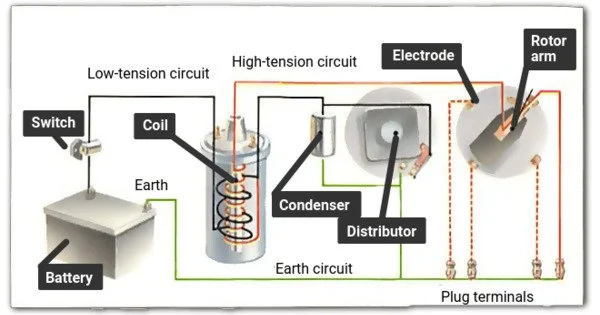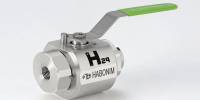Heat engines use ignition systems to start combustion by igniting the fuel-air mixture. It is a critical component of an internal combustion engine that initiates the combustion process. The ignition system of a spark ignition internal combustion engine (such as a petrol engine) creates a spark to ignite the fuel-air mixture just before each combustion stroke. Normally, gas turbine engines and rocket engines use an ignition system only during startup. Its primary function is to generate and deliver a high-voltage electric spark at precisely the right time to ignite the air-fuel mixture within the engine’s cylinders.
Diesel engines do not use an ignition system because they use compression ignition to ignite the fuel-air mixture using the heat of compression. Glowplugs are typically used to pre-heat the combustion chamber to aid starting in cold weather.
Traditional ignition systems in gasoline engines typically consist of the following main components:
- Battery: The battery provides the electrical power required for the ignition system to operate. It supplies a steady supply of low-voltage direct current (DC) electricity.
- Ignition switch: The ignition switch regulates the flow of electrical current from the battery to the ignition system. The ignition system receives power when the key is turned to the “ON” position.
- Ignition coil: The ignition coil is a transformer that steps up the low voltage from the battery to a much higher voltage, typically in the range of 20,000 to 50,000 volts. This high voltage is required to generate a spark capable of jumping across the spark plug gap.
- Distributor (in older systems): In older ignition systems, a distributor is used to distribute the high voltage from the ignition coil to each spark plug in the correct firing order. The distributor consists of a rotating rotor and a set of contacts (cap and rotor) that open and close to direct the spark to the correct cylinder.
- Spark plugs: Spark plugs are threaded into the engine’s cylinder head and are responsible for igniting the air-fuel mixture inside the combustion chamber. When the high voltage from the ignition coil reaches the spark plug, it creates an electrical arc across the spark plug gap, igniting the fuel.
Early automobiles used magneto and trembler coil ignition systems, which were eventually replaced by distributor-based systems (first used in 1912). Electronic ignition systems (first used in 1968) became common towards the end of the twentieth century, with coil-on-plug versions becoming common since the 1990s.
Overall, the ignition system plays a crucial role in starting and powering an internal combustion engine, allowing it to function properly by providing the necessary spark to ignite the air-fuel mixture and initiate combustion.
















